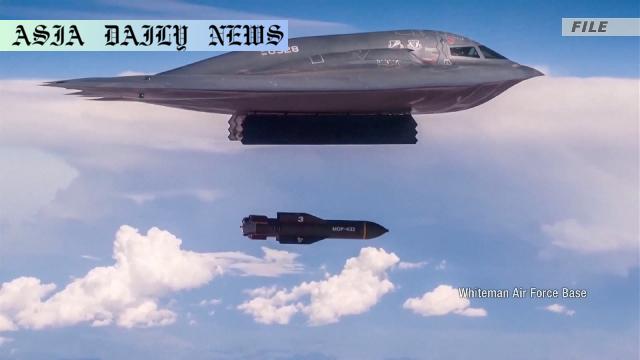Bunker Buster: US Defense Secretary Pete Hegseth confirmed the use of GBU-57 Massive Ordnance Penetrators on Iran’s Fordow facility.
- The US executed a strategic strike on Iran’s Fordow nuclear facility.
- A total of 14 GBU-57 Massive Ordnance Penetrators were deployed.
- The operation targeted deeply buried sites, avoiding civilians and troops.
- Tomahawk missiles followed up by targeting Isfahan’s facility.

The US Launches Strategic Strike on Iran’s Nuclear Facility
The United States launched a highly-coordinated attack on Iran’s Fordow nuclear site, utilizing the latest in military technology to target deeply buried facilities. A series of 14 GBU-57 Massive Ordnance Penetrators (MOP), commonly referred to as ‘bunker buster bombs,’ were deployed as part of the mission. The operation aimed to dismantle a critical component of Iran’s nuclear program, with Pentagon officials stating that the mission was both ‘incredible’ in execution and ‘overwhelming’ in success. The strikes were executed with precision, ensuring no Iranian troops or civilians were targeted, a fact reaffirmed by US Defense Secretary Pete Hegseth at a recent press conference in Washington.
The Technical Execution: A Mastery of Modern Warfare
At precisely 6:40 p.m. EST on Saturday, or 2:10 a.m. local time in Iran, the military operation began with a B-2 aircraft dropping two GBU-57 MOPs over the Fordow site. The first strike paved the way for successive bombers, which targeted multiple key points at the nuclear facility. Pentagon officials reported that the remaining bombers released a total of 14 bunker busters, ensuring the complete neutralization of the site’s nuclear capabilities. The final wave of the attack involved Tomahawk missile strikes directed at the Isfahan facility, a secondary aspect of Iran’s nuclear infrastructure. This systematic and phased strategy highlights the precision and calculated planning underpinning the operation.
Focus on Limiting Collateral Damage and International Ramifications
US Defense Secretary Pete Hegseth emphasized the care taken to avoid unnecessary casualties and collateral damage. “This was not about regime change,” Hegseth said, addressing concerns of escalation. The operation, in its entirety, sought to render Iran’s nuclear program ineffective without inflicting harm on civilians or military personnel, thereby maintaining a careful balance between military action and limiting international repercussions. This distinction is crucial in an era when military interventions draw worldwide scrutiny and dissent. Despite the scale of the operation, the Pentagon stressed its compliance with international conventions and commitment to operational ethics.
Strategic Importance and Future Implications
The Fordow strike marks a significant chapter in the broader geopolitical conflict between the United States and Iran, particularly regarding nuclear nonproliferation. By targeting a facility as heavily fortified as Fordow, the United States has underscored its capabilities in tackling advanced threats. The utilization of bunker buster bombs highlights technological advancements in modern warfare, where precision and impact are balanced against ethical considerations. However, the operation raises several questions about potential retaliation from Iran and the long-term effectiveness of such military interventions. Furthermore, global allies and adversaries alike will closely analyze the methods and outcomes of this mission as they reassess their positions and strategies in an increasingly complex international system.
A Remarkable Yet Contested Milestone
While the Pentagon celebrates the overwhelming success of the Fordow mission, it is not without controversy. Critics argue whether such operations genuinely deter future nuclear ambitions or merely exacerbate tensions. The restraint shown by the United States in avoiding civilian casualties is commendable and aligns with its broader narrative of focusing on strategic rather than punitive measures. However, the geopolitical ripples caused by the strike are bound to influence future negotiations and diplomatic relations in the Middle East. Whether this proves to be a turning point in the standoff over Iran’s nuclear ambitions or a catalyst for further discord remains to be seen.



Commentary
The Strategic Precision of Modern Warfare
In the ever-evolving landscape of global security, the ability to strike critical targets with precision while minimizing collateral damage is a remarkable feat. The United States’ latest operation against Iran’s Fordow nuclear facility exemplifies this capability. Deploying 14 GBU-57 bunker busters showcases not only the advanced technology at the Pentagon’s disposal but also the strategic foresight involved in executing such a mission. The careful planning that ensured no civilian or troop casualties is a testament to the United States’ adherence to international norms, even in the face of mounting tensions. This balance between technological prowess and ethical considerations sets a critical benchmark for modern military engagements.
The Geopolitical Ripple Effects
Although the mission’s operational success is commendable, its geopolitical implications cannot be ignored. Iran’s nuclear ambitions have long been a contentious issue on the world stage, with parties on both sides pushing for influence and leverage. By targeting Fordow so decisively, the United States has sent a clear message not just to Iran but also to other nations with similar ambitions. However, this raises questions: will this strike deter further nuclear developments or deepen hostilities? Each military operation carries the risk of unforeseen consequences, whether through retaliation or increased resistance against diplomatic resolutions.
The Fine Line Between Force and Diplomacy
The Fordow strike serves as a stark reminder of the delicate balance between wielding military power and pursuing diplomatic solutions. While the Pentagon’s restraint in avoiding civilian casualties is laudable, the broader narrative surrounding Iran and its nuclear program remains unresolved. Strategic strikes, even when executed flawlessly, are not a substitute for sustained and effective diplomacy. As the international community watches closely, it is essential to recognize that military success is only one aspect of ensuring global security. The true measure of this operation’s success will ultimately lie in its contribution to long-term stability and peace in the region.